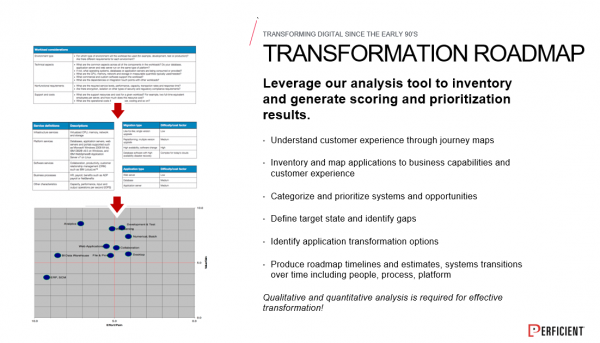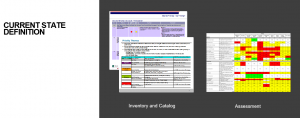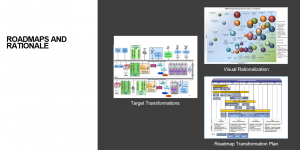Legacy systems are a challenge to a digital business model
The digital economy is accelerating and the businesses who are leading the way are the ones that deliver distinct business value using the most current data available in the most consumable means possible. The compelling reasons to modernize legacy IT applications and processes are to facilitate business agility, participate in the digital economy and improve customers’ user experience.
IT Modernization is motivated by technology megatrends such as cloud computing, artificial intelligence and the internet of things. Rarely do we engage on a modernization project today without considering a “cloud-first” approach. Our customers are moving large-scale systems like CRM and ERP to similar SaaS offerings. However, IT organizations are facing great challenges with key legacy IT systems that embody unique business models and customer value chains.
Legacy systems represent the business model and the state of business rules at a point in time. This embedded view of the business is invariably outdated and has become a barrier to innovation and a digital business model. Legacy systems often have dated and undesirable architecture, a cumbersome user experience and procedural code that does not map to modern application design.
The greatest challenge for legacy migration is understanding and reconciling the current-state to the future-state in terms of business and technical outcomes over time. The current-state is typically a tangle of undocumented legacy code and databases. There are transitional states of some combination of purchased software, refactored or rewritten applications and applications in various states of transition.
The future-state should also consider long-term technical trends and feasibility as well as business considerations for digital product offerings and revenue streams. The legacy modernization journey must also be done within the context of budgets and timelines, preferably with business value delivered along the way.
A Roadmap for Legacy Systems Transformation
In Perficient’s role of a digital transformation consulting firm we have been called upon many times to address the barriers legacy systems present to achieving our client’s digital business vision. To address the business and technical challenges migrating legacy systems presents, Perficient creates a transformation roadmap that addresses the digital business strategy, technical architecture, and IT people and process maturity.
From a strategic perspective, it is necessary to address and remediate systems that have the greatest business impact in terms of revenue, cost and customer experience. In the strategic view, a migration roadmap aligns business goals and the desired customer outcomes with systems plans and activities that provides incremental business value over the life of the systems transformation.
In the architecture view, it is necessary to analyze and model the as-is state of the application portfolio and categorize systems in terms of complexity, risk, dependencies and business capabilities. The strategic and architecture views then must be aligned to create a comprehensive transformation roadmap. The target-state application architecture should be expressed as model diagrams that show transitions over-time and reflect the target-state application domain organization and reference architecture.
The transformation roadmap addresses the following concerns and activities:
• Organization goals and barriers
• Customer experience through journey maps
• Technology assessment and inventory
• Gap analysis and recommendations
• Capture and reflect IT goals – e.g. Cloud-First, Agile, DevOps
• Establish a transformation roadmap that captures the vision of the digital transformation and the people, process and technology changes
• Technology options and reference architecture
• Application portfolio rationalization and migration options – e.g. buy versus build
• Budgets, benefits and timelines
• Change and communication plans
• Program governance – organization, roles and responsibilities, dashboard KPIs, accountability
• Reference architecture and digital marketplace offerings
• Program execution in the context of goals – Agility, Innovation, DevOps

Roadmap Approach
Perficient leverages a proven road mapping approach that we customize to address the unique needs of our client’s business and application portfolio. We have a prescriptive way to capture and catalog systems, but from a business perspective, we can create budgets and timelines needed specific to our client’s procurement processes. Similarly, we will adapt our technical architecture models to incorporate our client’s digital platform architecture and approaches to building modern applications.
Perficieint’s approach drives outcomes in business and technical terms by interviewing stakeholders and reviewing legacy systems in the context of what they do now and reconciles the application portfolio to the desired future-state architecture and user-experience design. Applications must be rationalized where duplication exists. Large-scale functionality sets can be moved to SaaS applications. However, discrete unique business functions and processes must be refactored to modern architecture such as microservices and configurable business processes.
The deliverables from the roadmap activities define the program timeline, costs and target-state architecture. Deliverables such as the program plan in terms of timelines, costs and resource planning help to justify, procure and manage the program. Considerations for migrating users and data as well as integrations between legacy and modern applications are also be outlined within the roadmap activities and accounted for in the overall migration budget.

Application Inventory
The architecture model diagrams and gap analysis define the target architecture and the steps needed to get to the target state. Model diagrams define migration options for each system and subsystem within the portfolio including buy versus build options. Model diagrams include business capability domains and can be used to identify candidate COTS components and the architecture for build components – e.g. legacy monolithic features to microservices domains.

Model Diagrams
The future-state application architecture will be defined in model diagrams within the context application components and the future-state reference architecture. Model diagrams depict systems transitions over time to the future-state, implementation tracks and the rationale behind architecture recommendations.
It is extremely important that all deliverables within the roadmap serve a purpose to further the desired business outcomes. Deliverables are customized to meet the business needs; for example, to justify and manage the program and to convey the desired architecture outcomes to stakeholders. Perficient has many artifacts and a proven road mapping process but we always customize the deliverables to best meet our client’s needs.
